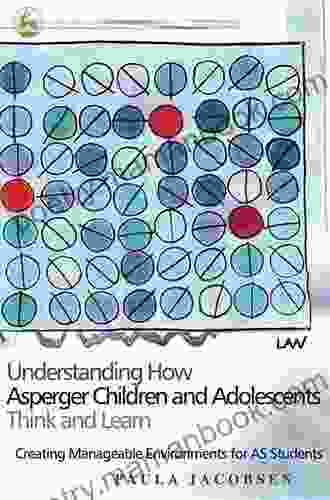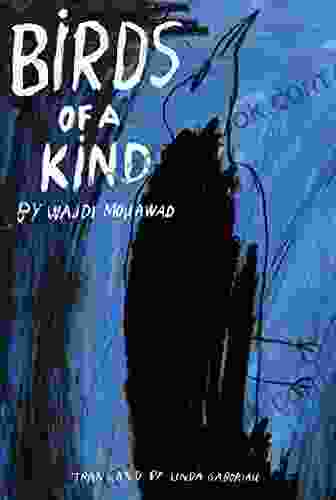Understanding How Asperger Children And Adolescents Think And Learn: An In-Depth Exploration

Asperger syndrome, now classified as autism spectrum disorder (ASD) Level 1, is a neurodevelopmental condition characterized by social and communication difficulties, along with restricted and repetitive patterns of behavior.
4.6 out of 5
| Language | : | English |
| File size | : | 1102 KB |
| Text-to-Speech | : | Enabled |
| Screen Reader | : | Supported |
| Enhanced typesetting | : | Enabled |
| Word Wise | : | Enabled |
| Print length | : | 122 pages |
Children and adolescents with Asperger syndrome exhibit unique cognitive and learning styles that set them apart from their neurotypical peers. Understanding these differences is crucial for educators, parents, and professionals to effectively support their educational and social development.
Cognitive Characteristics
Asperger children and adolescents often display strengths in:
- Attention to Detail: They exhibit an exceptional ability to focus on specific details and patterns, noticing subtle nuances easily overlooked by others.
- Logical Thinking: They possess a strong aptitude for logical reasoning and problem-solving, excelling in subjects such as mathematics and science.
- Memory: They have impressive memories and can recall vast amounts of information, especially in their areas of interest.
- Visual Processing: They tend to be visually oriented learners, excelling in tasks involving visual cues, maps, and diagrams.
However, they may also experience challenges in:
- Theory of Mind: They may find it difficult to understand and interpret the thoughts and emotions of others, leading to misunderstandings and social difficulties.
- Executive Functions: They may struggle with planning, organizing, and managing their time, as well as inhibiting impulsive behavior.
- Sensory Processing: They may be unusually sensitive to sensory stimuli such as noise, light, or touch, which can interfere with their attention and learning.
- Cognitive Flexibility: They may have difficulty adapting to changes in routine or perspective, preferring to stick to familiar patterns and routines.
Learning Styles
Asperger children and adolescents learn best in environments that cater to their unique learning styles:
- Structured and Predictable: They thrive in environments with clear routines, expectations, and visual cues that provide stability and predictability.
- Visual and Hands-On: They prefer learning through visual aids, models, or hands-on activities that engage their visual processing skills and allow them to connect with the material.
- Interest-Driven: They are highly motivated to learn about topics that genuinely interest them, so incorporating their interests into the curriculum can enhance engagement.
- Social Stories: Using social stories to explain social situations and expected behaviors can help them understand and navigate social interactions more effectively.
- Structured Social Skills Training: Targeted social skills training can provide them with explicit strategies for interacting with others and managing social challenges.
Implications for Educators and Parents
Recognizing the unique cognitive and learning styles of Asperger children and adolescents is essential for creating supportive and inclusive learning environments.
Educators can implement strategies such as:
- Providing clear and structured instructions
- Using visual aids and hands-on activities
- Allowing extra time for assignments
- Modifying assignments to cater to their strengths
- Providing opportunities for social skill development
Parents can support their children by:
- Providing a structured and predictable home environment
- Encouraging their interests and passions
- Helping them develop social skills through role-playing and social activities
- Seeking professional support when needed
- Advocating for their child's needs in school and the community
Asperger children and adolescents possess unique cognitive and learning styles that require specialized support to unleash their full potential. Understanding their strengths and challenges enables educators, parents, and professionals to create tailored educational and social environments that foster their success and well-being. By embracing their differences and providing tailored support, we can empower them to reach their full potential and thrive in all aspects of life.
Disclaimer: This article provides general information and should not be considered a substitute for professional advice. If you have concerns about your child's cognitive or learning style, consult with a qualified professional for personalized guidance.
4.6 out of 5
| Language | : | English |
| File size | : | 1102 KB |
| Text-to-Speech | : | Enabled |
| Screen Reader | : | Supported |
| Enhanced typesetting | : | Enabled |
| Word Wise | : | Enabled |
| Print length | : | 122 pages |
Do you want to contribute by writing guest posts on this blog?
Please contact us and send us a resume of previous articles that you have written.
 Top Book
Top Book Novel
Novel Fiction
Fiction Nonfiction
Nonfiction Literature
Literature Paperback
Paperback Hardcover
Hardcover E-book
E-book Audiobook
Audiobook Bestseller
Bestseller Classic
Classic Mystery
Mystery Thriller
Thriller Romance
Romance Fantasy
Fantasy Science Fiction
Science Fiction Biography
Biography Memoir
Memoir Autobiography
Autobiography Poetry
Poetry Drama
Drama Historical Fiction
Historical Fiction Self-help
Self-help Young Adult
Young Adult Childrens Books
Childrens Books Graphic Novel
Graphic Novel Anthology
Anthology Series
Series Encyclopedia
Encyclopedia Reference
Reference Guidebook
Guidebook Textbook
Textbook Workbook
Workbook Journal
Journal Diary
Diary Manuscript
Manuscript Folio
Folio Pulp Fiction
Pulp Fiction Short Stories
Short Stories Fairy Tales
Fairy Tales Fables
Fables Mythology
Mythology Philosophy
Philosophy Religion
Religion Spirituality
Spirituality Essays
Essays Critique
Critique Commentary
Commentary Glossary
Glossary Bibliography
Bibliography Index
Index Table of Contents
Table of Contents Preface
Preface Introduction
Introduction Foreword
Foreword Afterword
Afterword Appendices
Appendices Annotations
Annotations Footnotes
Footnotes Epilogue
Epilogue Prologue
Prologue Arin Murphy Hiscock
Arin Murphy Hiscock Solmaz Sharif
Solmaz Sharif Gayle Jessup White
Gayle Jessup White Timothy Crouse
Timothy Crouse Michelle Anderson
Michelle Anderson Tibor Gasparik
Tibor Gasparik Paul Neilan
Paul Neilan Mohammed Miah
Mohammed Miah Howland Blackiston
Howland Blackiston Robert Skidelsky
Robert Skidelsky Jason Gregory
Jason Gregory Eva Chance
Eva Chance Tatenda Kangwende
Tatenda Kangwende John Carlin
John Carlin Graham Ison
Graham Ison R B Lemberg
R B Lemberg Tyler Kent White
Tyler Kent White Cheri Fraker
Cheri Fraker Anabel Bright
Anabel Bright Susan J Lamon
Susan J Lamon
Light bulbAdvertise smarter! Our strategic ad space ensures maximum exposure. Reserve your spot today!

 Ian MitchellAn Introduction to the Languages of the World: Delving into the Enchanting...
Ian MitchellAn Introduction to the Languages of the World: Delving into the Enchanting...
 Keith CoxAda Twist's Unwavering Determination: Solving the Mystery of the Disappearing...
Keith CoxAda Twist's Unwavering Determination: Solving the Mystery of the Disappearing... Neal WardFollow ·12k
Neal WardFollow ·12k Jack LondonFollow ·7k
Jack LondonFollow ·7k Demetrius CarterFollow ·11.9k
Demetrius CarterFollow ·11.9k Vic ParkerFollow ·17.9k
Vic ParkerFollow ·17.9k Juan ButlerFollow ·12.6k
Juan ButlerFollow ·12.6k Hamilton BellFollow ·9.6k
Hamilton BellFollow ·9.6k Carlos DrummondFollow ·9.1k
Carlos DrummondFollow ·9.1k Dwight BellFollow ·10.5k
Dwight BellFollow ·10.5k

 Patrick Hayes
Patrick HayesDeath on Stage: Euphemia Martins Mystery 16
Synopsis In the...

 Benji Powell
Benji Powell1001 Best Baking Recipes Of All Time
Baking is a fun and...

 Terry Bell
Terry BellDestined War of the Covens: A Supernatural Saga of Power,...
Welcome to the...

 Mark Twain
Mark TwainBitcoin For Mere Mortals: A Comprehensive Guide for...
Bitcoin is a...

 Dennis Hayes
Dennis HayesThe Best Budget Gaming PC 2024: Build the Ultimate Gaming...
Are you looking to build the best budget...
4.6 out of 5
| Language | : | English |
| File size | : | 1102 KB |
| Text-to-Speech | : | Enabled |
| Screen Reader | : | Supported |
| Enhanced typesetting | : | Enabled |
| Word Wise | : | Enabled |
| Print length | : | 122 pages |









